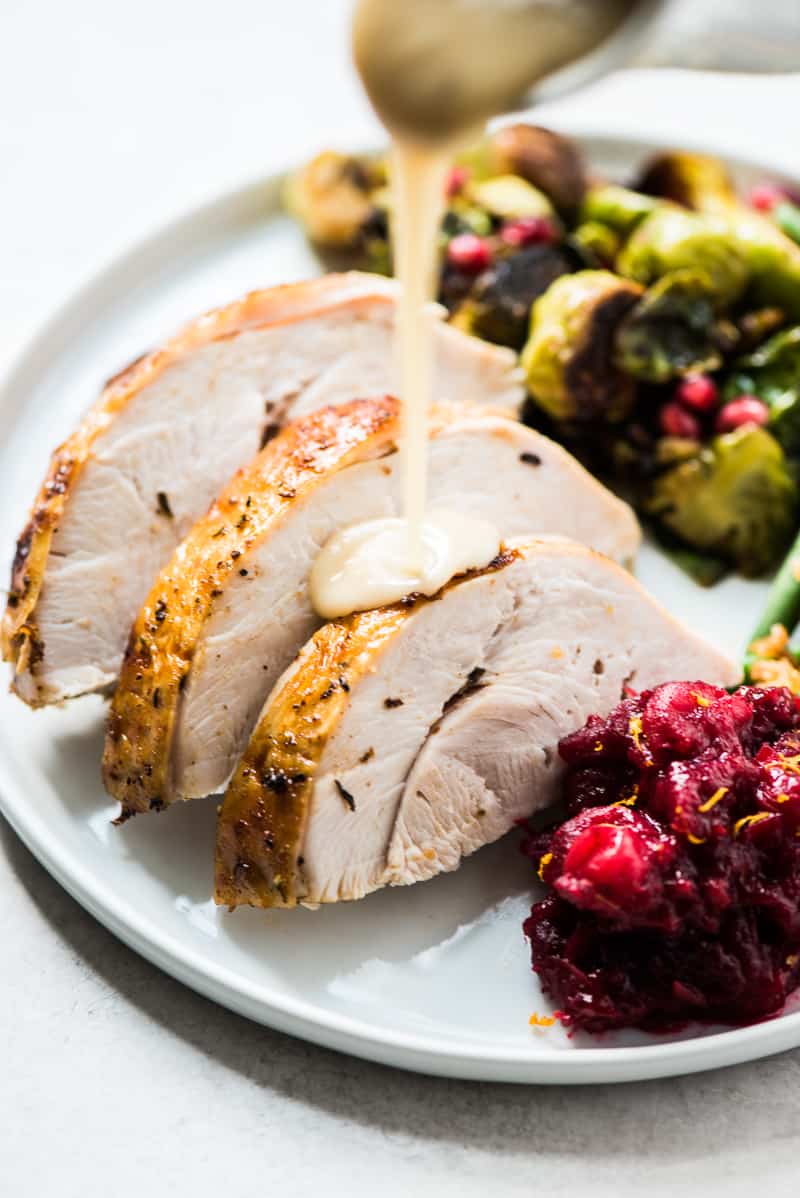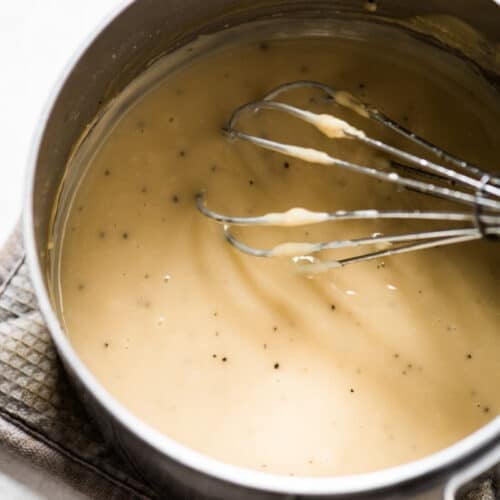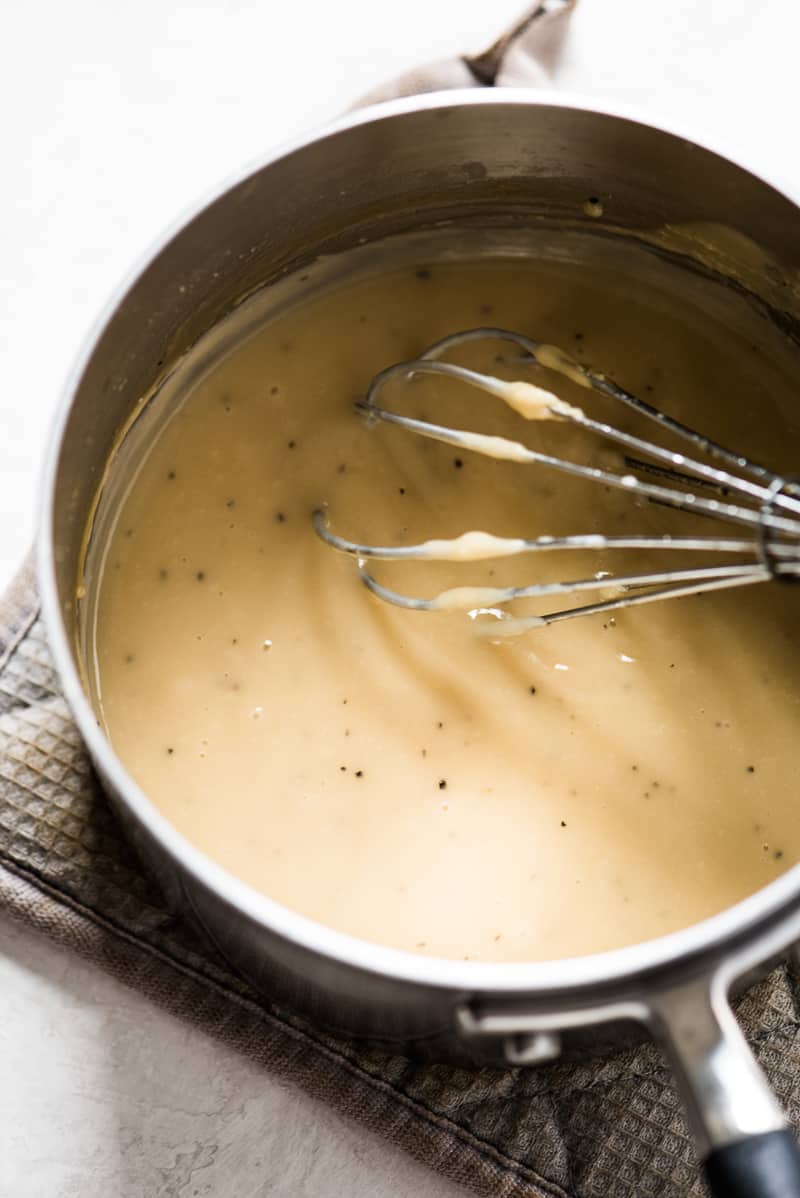Learn how to make turkey gravy from drippings the easy way. Don’t let all the seasonings and juicy pan drippings from your turkey go to waste!
Don’t let all the seasonings and juicy pan drippings from your turkey go to waste. Use all those delicious brown bits at the bottom of your roasting pan to make the best turkey gravy recipe ever!
I don’t know about you, but if there’s a good gravy on the dinner table, you can bet that I love pouring it all over my plate, not just on the meat. Gravy on the mashed potatoes, gravy on the green beans, gravy on the Brussels sprouts, gravy everywhere! That’s when you know it’s good.
Making turkey gravy from drippings is one of the easiest and best ways to make a flavorful and rich gravy that enhances the flavor of that Thanksgiving turkey you worked so hard to make. Best of all, you can make it while your turkey is resting and cooling down so it can be carved.
#What To Do With Turkey Juice After Roasting Creative Uses For Those Flavorful Drippings
The savory juices left behind after roasting a turkey are liquid gold. Known as drippings or pan juices this flavorful liquid is full of taste from the herbs spices, and natural juices of the turkey. Rather than pouring those precious drippings down the drain, there are many delicious ways to use them.
Make Turkey Gravy
The most popular use for turkey drippings is to make gravy. This classic sauce pairs perfectly with roasted turkey and mashed potatoes. To make gravy, you’ll need:
- Turkey drippings/pan juices
- Flour
- Chicken or turkey broth
- Salt, pepper and other seasonings
Start by pouring the drippings into a measuring cup Let the fat rise and skim it off the top. Reserve 2-3 tablespoons of fat in a saucepan and whisk in an equal amount of flour to make a roux Cook the roux for 2-3 minutes then slowly whisk in 1-2 cups of broth, scraping any browned bits off the bottom of the pan. Simmer until thickened then season with salt, pepper and other spices like thyme or sage. For a smoother gravy, strain through a fine mesh sieve.
Making your own gravy only takes about 10 minutes but packs a huge flavor punch.
Use for Soups and Stews
Another great way to use turkey drippings is as the base for soups and stews. The drippings add tons of flavor. To make turkey broth:
- Place drippings in a pot with onion, carrot, celery and fresh herbs
- Add enough water to cover vegetables
- Simmer for 1-2 hours
- Strain and use broth for soups like turkey noodle soup or turkey and rice soup
You can also freeze turkey broth in batches to have on hand for future soup making.
Make a Flavorful Rice Dish
Incorporate drippings into rice for a one-pot meal. Try adding rice, broth and chopped veggies like celery, carrots, onion and garlic to the drippings. Season with salt, pepper and poultry seasoning. Simmer until rice is cooked through and liquid is absorbed. The drippings infuse the rice with lots of extra flavor.
Use for Cooking Beans or Lentils
The next time you cook beans or lentils, add a few spoonfuls of turkey drippings. It gives them a wonderful depth of flavor. Saute aromatics like onion and garlic in the drippings then add beans, broth and seasonings. Simmer until tender. The drippings act as a flavor booster.
Make Turkey Hash
Leftover turkey and veggies sauteed in drippings makes for amazing hash. Simply chop and cook turkey meat, potatoes, onion, celery, carrots and brussels sprouts in the drippings until lightly browned. The rendered fat gives the hash delicious flavor. Season with salt, pepper and fresh herbs.
Moisten Leftover Turkey
Drippings can be used to add moisture back to leftover roasted turkey. Simply warm the drippings and brush or drizzle over sliced turkey before reheating. It keeps the meat tender and juicy.
Make Savory Turkey Pot Pie
For the ultimate comfort food, make turkey pot pie with the drippings. Saute onion, carrots, celery and peas in the drippings then stir in milk, broth and flour to make a thick sauce. Add turkey meat, transfer to a pie dish and top with biscuits or pie crust. Bake until golden. The drippings give the filling a wonderful depth of savoriness.
Pan Sauce for Turkey Cutlets
Transform leftover turkey cutlets by simmering them in a quick pan sauce made with the drippings. Cook sliced turkey cutlets in the drippings over medium-high heat until browned. Add chicken broth, lemon juice, capers and parsley. Simmer until reduced to a glaze-like consistency then drizzle over the cutlets.
Make Gravy for Breakfast
Drippings aren’t just for dinner! Make turkey sausage gravy for breakfast by browning bulk sausage in the drippings then making a creamy gravy with milk and flour. Pour over biscuits for an amazing savory breakfast treat.
Flavor Vegetables
Turkey drippings can be used to roast potatoes, carrots, parsnips, brussels sprouts and other veggies. The rendered fat gives them incredible flavor. Rough chop vegetables, toss with drippings and roast at 400F until tender and caramelized.
Make Stuffing or Dressing
For moister stuffing, add a few spoonfuls of drippings. The fat will flavor and moisten up any stuffing recipe. You can also make stuffing from scratch by sauteing aromatics like onion, celery and sage in the drippings before adding bread cubes and broth.
Marinate Other Meats
The possibilities don’t stop with turkey! Use the drippings to impart flavor into pork, chicken, or beef. Whisk together olive oil, drippings, garlic, and herbs like rosemary or thyme to create an easy marinade.
Make Turkey Bacon
If you have a good amount of drippings, pour into ice cube trays and freeze. Use turkey fat cubes to fry up potatoes or eggs for a turkey bacon flavor.
Make Flavored Butter
Freeze drippings in a stick shape until solid. Blend into softened butter along with herbs and spices for a unique flavored butter. Spread on biscuits, corn bread or rolls.
As you can see, turkey drippings are incredibly versatile in the kitchen. With a little creativity, you can transform those pan drippings into all kinds of delicious dishes. Don’t throw away the liquid gold after roasting your turkey!
:max_bytes(150000):strip_icc()/Roastingaturkey2500-5a12753c22fa3a003680959c.jpg)
What to Serve with Turkey Gravy
If you’re making this gravy for an upcoming Thanksgiving or Christmas celebration, here are a few serving suggestions:

- Medium saucepan. Perfect for making the gravy. This saucepan distributes heat evenly and reduces the chance of burning.
- Strainer. Useful to strain out any bits from the drippings for a smoother gravy. This one comes in three different sizes.
- Whisk. Essential for ensuring a smooth and lump-free gravy. This comes in a set of three different sizes.
Leftover gravy can be stored in an airtight container in the refrigerator for 2 to 3 days.
To reheat, heat the gravy in a saucepan over medium-high heat for 5 minutes until warmed. You may need to whisk in a splash of broth or water to thin it out. You can also reheat it in the microwave for 2 to 3 minutes, stirring every minute.

How to make turkey gravy from drippings
- Carefully pour the turkey drippings through a strainer and into a large glass container or two. Place them in the fridge for 15 minutes to let the fat rise to the top and solidify.
- Remove the drippings from the fridge, scoop out 2 tablespoons of the fat, and discard the remaining fat (or transfer it to a storage container to use later). You should now have only the liquid turkey drippings remaining.
- In a small saucepan over medium-high heat, whisk together the 2 tablespoons of reserved fat and the all-purpose flour until smooth. Cook for 1 to 2 minutes, whisking constantly, until bubbly and light to golden brown.
- Whisk in 1 cup of the turkey drippings and 1 cup of stock until completely smooth. Bring it to a boil, reduce the heat to a simmer, and cook until the gravy has thickened to your liking. Taste and season with salt and black pepper as needed.

- If you don’t get two tablespoons of fat from your turkey drippings, you can use two tablespoons of butter instead.
- Use unsalted, low-sodium turkey or chicken broth if possible. Since the pan drippings may already be salty, I recommend using low-sodium or unsalted stock if you can find it. Then, you can taste the finished gravy and add salt and black pepper as needed.
- If your gravy has thickened too much, whisk in more turkey or chicken stock, one tablespoon at a time, until it’s thinned out to your liking.
- If your gravy isn’t thickening, a quick fix is to whisk in a little bit of cornstarch.
- The color of your gravy can vary from light to dark brown, depending on the spices and seasonings used to make your turkey.
How to Make Gravy From Drippings | EASIEST METHOD EVER!
FAQ
Do you drain turkey juice?
What to do with roasting juices?
Do you leave turkey to rest in its juices?
What can I do with turkey drippings besides gravy?
